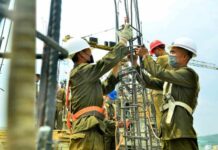Immediately after an ICBM exploded in mid-air on Mar. 16, North Korean authorities ordered a military unit to find and collect missile debris, Daily NK has learned.
A source in Pyongyang told Daily NK on Monday that the authorities ordered Kang Gon Military Officer’s Training School to do the primary cleanup of debris right after the explosion. A team from the school spread out and searched the environs for three days.
Located in Pyongyang’s Sunan District, Kang Gon Military Officer’s Training School is analogous to the Korea Military Academy in Seoul. Given that the ICBM launch was conducted in Pyongyang’s Sunan Airfield, North Korea apparently tried to maintain security by quickly ordering the military facility closest to the explosion to handle the situation.
The source said the Central Committee later ordered party, law enforcement, and security apparatuses in Pyongyang’s Sunan and Ryongsong districts, and in the city of Pyongsong, South Pyongan Province, to collect debris as well. The gist of the order was that personnel should report to their superiors immediately upon discovering debris because missile debris is a “top military secret.”
Pyongyang’s Ryongsong District is about 13 km southeast of Sunan Airfield, while Pyongsong is about 18 km northeast of the airfield. This basically means the authorities ordered an intensive search within a 15 km radius of the launch site. This lends credence to claims that the debris fell some distance from downtown Pyongyang.
According to South Korean military authorities, the ICBM exploded in-flight at a point less than 20 km high. Sunan Airfield is over 20 km from the center of Pyongyang. Because North Korea launched the missile at a certain angle, it likely exploded above the outskirts of Pyongyang, not the central downtown area.
South Korean lawmaker Ha Tae-keung of the People Power Party said after a closed-door briefing of the legislature’s National Defense Committee on Mar. 29 that missile fragments rained down on Pyongyang after a Hwasong-17 ICBM launched on Mar. 16 exploded several kilometers above the city. He said locals were startled by the blast, and civilians suffered “damage.”
However, Pyongyang residents are reportedly being kept in the dark about what, if any, damage was done by the falling debris.
The source said he heard no talk of human losses or property damage as a result of the missile explosion, perhaps because fields and mountains account for much of the outskirts of Pyongyang and nobody was farming at the time.
However, given the North Korean regime’s penchant for information control, ordinary people would likely hear nothing even if the falling debris caused civilian losses.
At least so far, Daily NK understands that nobody has stolen missile debris or reported debris to the authorities. The source said he has heard nothing about people secretly pilfering missile fragments, nor has he heard of anyone reporting that they have spotted debris.
Please direct any comments or questions about this article to dailynkenglish@uni-media.net.


















